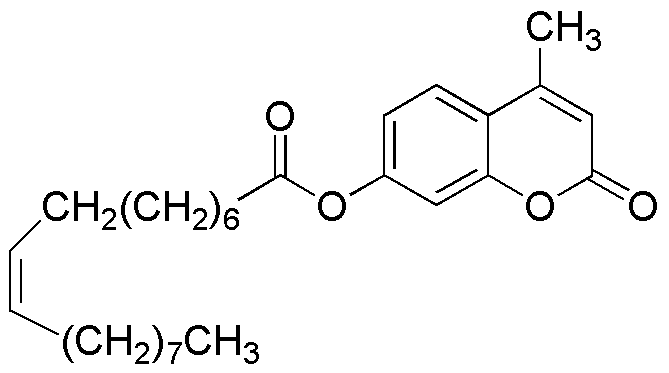4-Methylumbelliferyl oleate is widely utilized in research focused on:
- Enzyme Activity Assays: This compound serves as a substrate for various enzymes, allowing researchers to measure enzyme activity in biological samples. Its fluorescence upon hydrolysis provides a sensitive detection method.
- Cell Biology: It is used in cell culture studies to investigate lipid metabolism and membrane dynamics, helping scientists understand cellular processes and disease mechanisms.
- Food Industry: The compound can be applied in food science to study lipid oxidation, aiding in the development of better preservation methods and improving food quality.
- Pharmaceutical Research: It plays a role in drug formulation and testing, particularly in evaluating the bioavailability of lipid-based drugs, which can enhance therapeutic efficacy.
- Environmental Monitoring: 4-Methylumbelliferyl oleate can be used to assess the activity of microbial communities in environmental samples, providing insights into ecosystem health and pollution effects.
Informations générales
Propriétés
Sécurité et réglementation
Applications
4-Methylumbelliferyl oleate is widely utilized in research focused on:
- Enzyme Activity Assays: This compound serves as a substrate for various enzymes, allowing researchers to measure enzyme activity in biological samples. Its fluorescence upon hydrolysis provides a sensitive detection method.
- Cell Biology: It is used in cell culture studies to investigate lipid metabolism and membrane dynamics, helping scientists understand cellular processes and disease mechanisms.
- Food Industry: The compound can be applied in food science to study lipid oxidation, aiding in the development of better preservation methods and improving food quality.
- Pharmaceutical Research: It plays a role in drug formulation and testing, particularly in evaluating the bioavailability of lipid-based drugs, which can enhance therapeutic efficacy.
- Environmental Monitoring: 4-Methylumbelliferyl oleate can be used to assess the activity of microbial communities in environmental samples, providing insights into ecosystem health and pollution effects.
Documents
Fiches de données de sécurité (FDS)
La FDS fournit des informations de sécurité complètes sur la manipulation, le stockage et l’élimination du produit.
Spécifications du produit (PS)
Le PS fournit une description complète des propriétés du produit, notamment sa composition chimique, son état physique, sa pureté et les exigences de stockage. Il détaille également les plages de qualité acceptables et les applications prévues du produit.
Certificats d'analyse (COA)
Recherchez des certificats d'analyse (COA) en saisissant le numéro de lot du produit. Les numéros de lot et de lot se trouvent sur l'étiquette d'un produit, après les mots « Lot » ou « Lot de fabrication ».
Numéro de catalogue
Numéro de lot/série
Certificats d'origine (COO)
Ce certificat d'exploitation confirme le pays dans lequel le produit a été fabriqué, et détaille également les matériaux et composants utilisés et s'il est issu de sources naturelles, synthétiques ou autres sources spécifiques. Ce certificat peut être requis pour les douanes, le commerce et la conformité réglementaire.
Numéro de catalogue
Numéro de lot/série
Fiches de données de sécurité (FDS)
La FDS fournit des informations de sécurité complètes sur la manipulation, le stockage et l’élimination du produit.
DownloadSpécifications du produit (PS)
Le PS fournit une description complète des propriétés du produit, notamment sa composition chimique, son état physique, sa pureté et les exigences de stockage. Il détaille également les plages de qualité acceptables et les applications prévues du produit.
DownloadCertificats d'analyse (COA)
Recherchez des certificats d'analyse (COA) en saisissant le numéro de lot du produit. Les numéros de lot et de lot se trouvent sur l'étiquette d'un produit, après les mots « Lot » ou « Lot de fabrication ».
Numéro de catalogue
Numéro de lot/série
Certificats d'origine (COO)
Ce certificat d'exploitation confirme le pays dans lequel le produit a été fabriqué, et détaille également les matériaux et composants utilisés et s'il est issu de sources naturelles, synthétiques ou autres sources spécifiques. Ce certificat peut être requis pour les douanes, le commerce et la conformité réglementaire.


